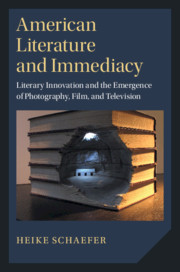 American Literature and Immediacy
American Literature and Immediacy Book contents
- American Literature and Immediacy
- Cambridge Studies in American Literature and Culture
- American Literature and Immediacy
- Copyright page
- Dedication
- Contents
- Acknowledgements
- The Quest for Immediacy in American Literature and Media Culture
- Part I Literary Immediacy and Photography
- Part II Literary Immediacy and the Cinema
- Chapter 4 “Living Moving Pictures”: The Thrills of Early Cinema
- Chapter 5 “Making a Cinema of It”: Seriality and Presence in Gertrude Stein’s Early Literary Portraits
- Chapter 6 “A Novel Like a Documentary Film”: Cinematic Writing as Cultural Critique in John Dos Passos’s Manhattan Transfer
- Part III Literary Immediacy and Television
- Notes
- Bibliography
- Index
- Series page
Chapter 5 - “Making a Cinema of It”: Seriality and Presence in Gertrude Stein’s Early Literary Portraits
from Part II - Literary Immediacy and the Cinema
Published online by Cambridge University Press: 19 December 2019
- American Literature and Immediacy
- Cambridge Studies in American Literature and Culture
- American Literature and Immediacy
- Copyright page
- Dedication
- Contents
- Acknowledgements
- The Quest for Immediacy in American Literature and Media Culture
- Part I Literary Immediacy and Photography
- Part II Literary Immediacy and the Cinema
- Chapter 4 “Living Moving Pictures”: The Thrills of Early Cinema
- Chapter 5 “Making a Cinema of It”: Seriality and Presence in Gertrude Stein’s Early Literary Portraits
- Chapter 6 “A Novel Like a Documentary Film”: Cinematic Writing as Cultural Critique in John Dos Passos’s Manhattan Transfer
- Part III Literary Immediacy and Television
- Notes
- Bibliography
- Index
- Series page
Summary
Stein used film as a model to explain the avant-garde poetics of her literary portraits to her perplexed readers. The chapter examines two early portraits, “Picasso” and “Orta,” in the context of chronophotography and early film. It also considers Stein’s theoretical reflections on her insistent style, particularly “Portraits and Repetition” and “How Writing Is Written.” Stein’s early portraits are in orientation temporal and performative (like film) rather than visual and static (like photography). They advance through sequences of similar, serially varied sentences that create the impression of an ongoing present. Stein’s cinematic form of serial variation locates meaning in the movement of its sentence permutations rather than in its mimetic capacities. Her serial sentences keep readers focused on the workings of language and the text’s temporal unfolding and thus manage to turn an awareness of representational processes into a tool to center our attention on the always elusive present moment. Stein’s use of self-reflexivity to create a sense of temporal and perceptual immediacy radicalizes the cinematic strategy of embedding immediacy effects in overtly self-referential texts.
Keywords
- Type
- Chapter
- Information
- American Literature and ImmediacyLiterary Innovation and the Emergence of Photography, Film, and Television, pp. 116 - 142Publisher: Cambridge University PressPrint publication year: 2020


